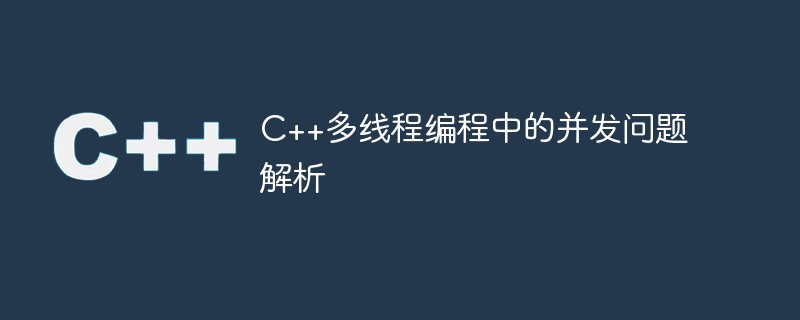C++多线程编程中的并发问题解析
- 王林原创
- 2023-10-08 11:05:061376浏览

C++多线程编程中的并发问题解析
随着计算机硬件的不断发展,多核处理器已经成为了主流。在这种情况下,使用多线程来充分利用多核处理器的性能,成为了程序开发中的一项重要技术。然而,在多线程编程中,由于多个线程之间的并发操作,常常会导致一些问题,这些问题被称为并发问题。本文将通过具体的代码示例,来解析C++多线程编程中的并发问题。
- 线程间的共享资源竞争
当多个线程同时访问和修改共享资源时,容易造成数据竞争。数据竞争的结果是不可预期的,可能导致程序发生错误。以下是一个简单的示例代码:
#include <iostream>
#include <thread>
int count = 0;
void increment()
{
for (int i = 0; i < 100000; ++i)
{
count++;
}
}
int main()
{
std::thread t1(increment);
std::thread t2(increment);
t1.join();
t2.join();
std::cout << "count: " << count << std::endl;
return 0;
}上述代码中,两个线程并发地对count进行自增操作。由于两个线程同时访问和修改count,很可能导致数据竞争。运行上述代码,其结果是不确定的,每次运行的结果都可能不同。
解决这个问题的方法是引入互斥锁或原子操作。对上述代码进行改进:
#include <iostream>
#include <thread>
#include <mutex>
int count = 0;
std::mutex mtx;
void increment()
{
for (int i = 0; i < 100000; ++i)
{
std::lock_guard<std::mutex> lock(mtx);
count++;
}
}
int main()
{
std::thread t1(increment);
std::thread t2(increment);
t1.join();
t2.join();
std::cout << "count: " << count << std::endl;
return 0;
}在改进后的代码中,引入了一个互斥锁mtx,通过std::lock_guard<:mutex></:mutex>来对互斥锁进行自动加锁和解锁。这样,在increment函数中对count进行修改时,会先加锁,保证同一时间只有一个线程能够访问和修改共享资源。运行改进后的代码,可以得到正确的结果。mtx,通过std::lock_guard<:mutex></:mutex>来对互斥锁进行自动加锁和解锁。这样,在increment函数中对count进行修改时,会先加锁,保证同一时间只有一个线程能够访问和修改共享资源。运行改进后的代码,可以得到正确的结果。
- 死锁
另一个常见的并发问题是死锁。死锁是指两个或多个线程相互等待对方释放锁而无法继续执行的情况。以下是一个简单的死锁示例代码:
#include <iostream>
#include <thread>
#include <mutex>
std::mutex mtx1, mtx2;
void thread1()
{
std::lock_guard<std::mutex> lock1(mtx1);
std::this_thread::sleep_for(std::chrono::seconds(1));
std::lock_guard<std::mutex> lock2(mtx2);
std::cout << "Thread 1" << std::endl;
}
void thread2()
{
std::lock_guard<std::mutex> lock2(mtx2);
std::this_thread::sleep_for(std::chrono::seconds(1));
std::lock_guard<std::mutex> lock1(mtx1);
std::cout << "Thread 2" << std::endl;
}
int main()
{
std::thread t1(thread1);
std::thread t2(thread2);
t1.join();
t2.join();
return 0;
}上述代码中,thread1和thread2两个线程分别对mtx1和mtx2进行加锁。但是在加锁后,它们又试图对另一个锁进行加锁,从而形成了相互等待的死锁情况。这将导致程序无法继续执行。
解决死锁问题的方法是对锁的获取顺序进行统一。即,所有线程在获取锁的时候,都按照相同的顺序获取锁。修改上述代码:
void thread1()
{
std::lock_guard<std::mutex> lock1(mtx1);
std::this_thread::sleep_for(std::chrono::seconds(1));
std::lock_guard<std::mutex> lock2(mtx2);
std::cout << "Thread 1" << std::endl;
}
void thread2()
{
std::lock_guard<std::mutex> lock1(mtx1);
std::this_thread::sleep_for(std::chrono::seconds(1));
std::lock_guard<std::mutex> lock2(mtx2);
std::cout << "Thread 2" << std::endl;
}在改进后的代码中,对锁的获取顺序进行了统一,都是先获取mtx1,再获取mtx2
- 死锁
另一个常见的并发问题是死锁。死锁是指两个或多个线程相互等待对方释放锁而无法继续执行的情况。以下是一个简单的死锁示例代码:
rrreee🎜上述代码中,thread1和thread2两个线程分别对mtx1和mtx2进行加锁。但是在加锁后,它们又试图对另一个锁进行加锁,从而形成了相互等待的死锁情况。这将导致程序无法继续执行。🎜🎜解决死锁问题的方法是对锁的获取顺序进行统一。即,所有线程在获取锁的时候,都按照相同的顺序获取锁。修改上述代码:🎜rrreee🎜在改进后的代码中,对锁的获取顺序进行了统一,都是先获取mtx1,再获取mtx2。这样,就避免了死锁的发生。🎜🎜总结:🎜🎜多线程编程中的并发问题是程序开发中常见的问题之一。本文通过具体的代码示例,简单介绍了并发问题中的共享资源竞争和死锁问题,并给出了相应的解决方案。在实际编程中,我们需要更加深入地了解多线程编程的原理和技术,以避免并发问题的发生,保证程序运行的正确性和稳定性。🎜以上是C++多线程编程中的并发问题解析的详细内容。更多信息请关注PHP中文网其他相关文章!

